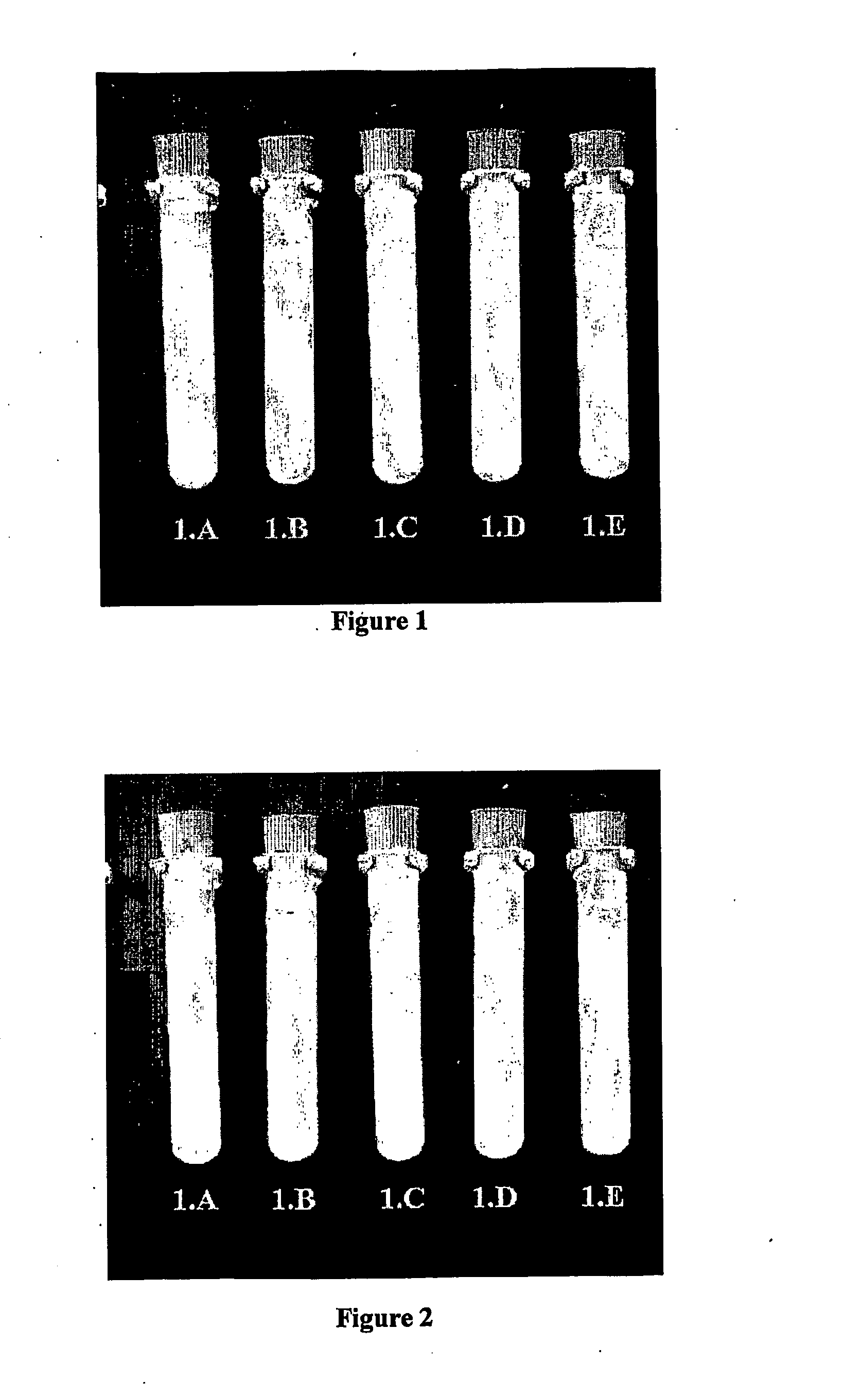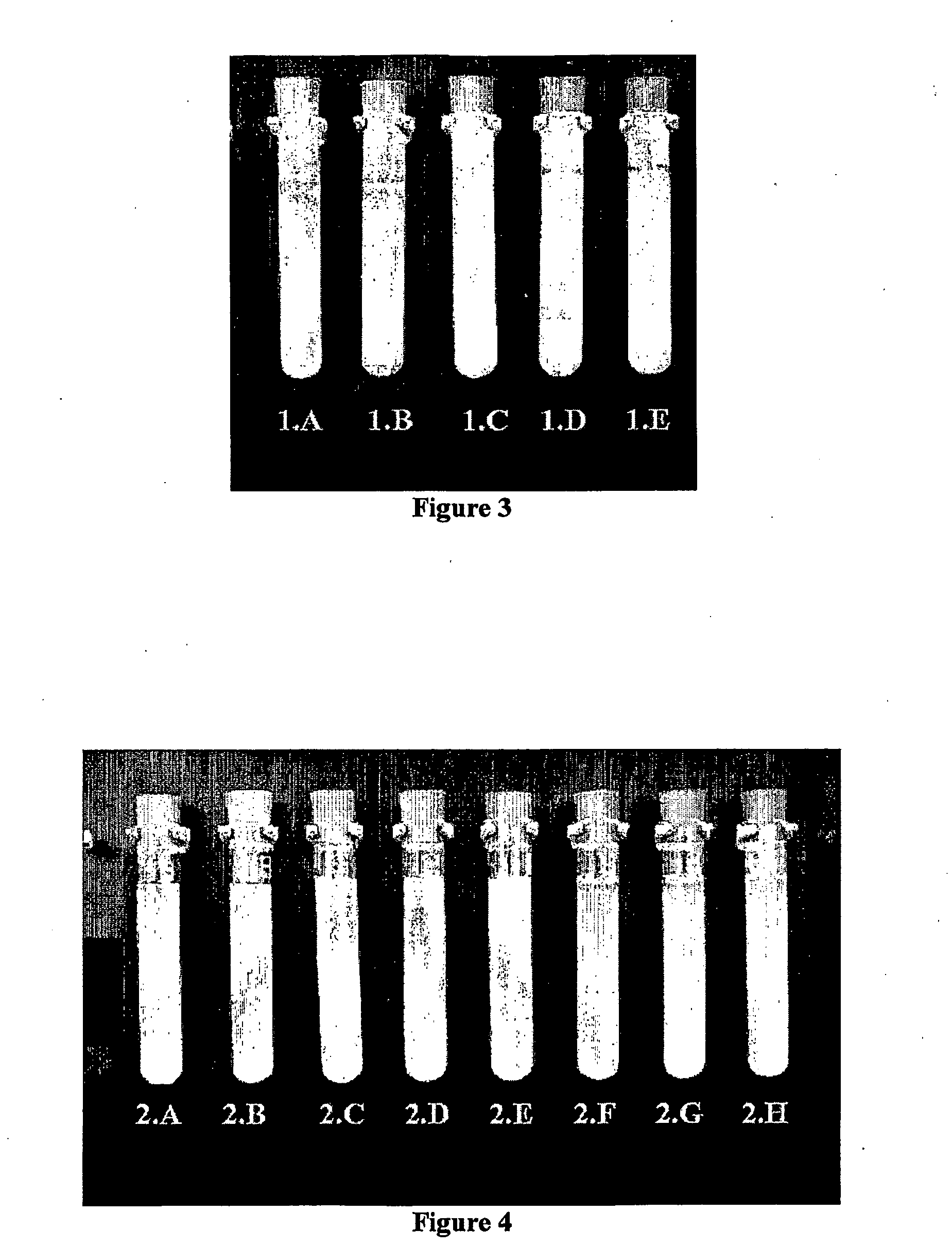Stimulant sensitive flocculation and consolidation
a technology of stimulant and flocculation, which is applied in the field of separation methods, can solve the problems of complex process of efficiently and quickly separating solid particles from fluids, difficult operation of removal of particles from liquids, and difficulty in recovering associated fluid phases
- Summary
- Abstract
- Description
- Claims
- Application Information
AI Technical Summary
Benefits of technology
Problems solved by technology
Method used
Image
Examples
example 1
Electrical Double Layer, pH, Stimulated Flocculation and Consolidation of Alumina
[0131]A commercial high purity alpha alumina powder (AKP-30, Sumitomo Corp. Japan) with a average particle size of about 0.3 μm and a density of 3.97 g cm−3 was dispersed in de-ionised water as a 10% w / w suspension at its natural pH near 6. Each of five test tubes of approx. 60 mL volume was filled with 50 g of the 10% w / w alumina suspension. Tube 1.A was adjusted to pH 4.0 with HCl. Tube 1.B was adjusted to pH 6.0 with KOH. Tube 1.C, 1.D, and 1.E were adjusted to pH 8.8. The isoelectric point of alumina powder is about pH 9 and at pH below 7 significant positive surface charge results (Franks and Meagher, 2003). The suspensions in the tubes at pH 4 and 6 remained suspended for at least 89 h while the suspensions in the tubes at pH 8.8 rapidly aggregated and settled out. (See FIGS. 1,2 and 3). After 2 h of sedimentation the rate of settling had decreased significantly in the tubes at pH 8.8 (FIG. 2). Af...
example 2
Electrical Double Layer, pH, Stimulated Flocculation and Consolidation of Silica
[0132]Silica (ground quartz, 99% pure) with an average particle size of approximately 2 μm was purchased from Sigma Aldrich. 10% w / w silica was dispersed in distilled water. Each of eight test tubes of approx. 60 mL volume was filled with 50 g of the 10% w / w silica suspension. Tube 2.A was adjusted to pH 5.0 with HCl. Tube 2.B was adjusted to pH 7.0 with KOH. Tubes 2.C, 2.D and 2.E was adjusted to pH 3.8 with HCl. Tubes 2.F, 2.G, and 2.H were adjusted to pH 3.25 with HCl. The suspensions in the tubes at pH 5 and 7 remained stable for at least 22 h, while the suspension in the tubes at pH 3.8 and 3.25 rapidly aggregated and settled out (see FIGS. 4, 5 and 6). The isoelectric point (IEP) of silica is at about pH 3.0; at pH above 5 significant negative surface charge develops (Tadros and Lyklema, 1968).
[0133]The surface charge creates an electrical double layer repulsion at pH 5 and above resulting in the s...
example 3
Electrical Double Layer, pH, Stimulated Flocculation and Consolidation of Titania and Zircon
[0135]A submicron titania powder (CR826 from Kerr-McGee Chemical, Oklahoma City, USA) with an isoelectric point (IEP) of about pH 7.8 was prepared as a 10% w / w suspension at pH about 7.5. Each of three test tubes of approx. 60 mL volume was filled with 50 g of the 10% w / w titania suspension. Tube 3.A was adjusted to pH 4.3 with HCl. Tubes 3.B and 3.C were kept at pH 7.5.
[0136]A zircon powder was obtained from Opacfine, Australia. It had a density of about 4.4 g cm−3, about 6 μm average size and an isoelectric point (IEP) of about pH 3.8. It was prepared as a 10% w / w suspension in water at pH about 4.0. Each of three test tubes of approx. 60 mL volume was filled with 50 g of the 10% w / w zircon suspension. Tube 3.D was adjusted to pH 9.2 with KOH. Tubes 3.E and 3.F were kept at pH 4.0.
[0137]All six tubes were shaken vigorously for about 30 sec and set in a rack and allowed to sediment while pho...
PUM
 Login to View More
Login to View More Abstract
Description
Claims
Application Information
 Login to View More
Login to View More - R&D
- Intellectual Property
- Life Sciences
- Materials
- Tech Scout
- Unparalleled Data Quality
- Higher Quality Content
- 60% Fewer Hallucinations
Browse by: Latest US Patents, China's latest patents, Technical Efficacy Thesaurus, Application Domain, Technology Topic, Popular Technical Reports.
© 2025 PatSnap. All rights reserved.Legal|Privacy policy|Modern Slavery Act Transparency Statement|Sitemap|About US| Contact US: help@patsnap.com



